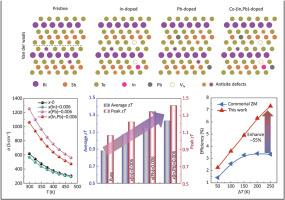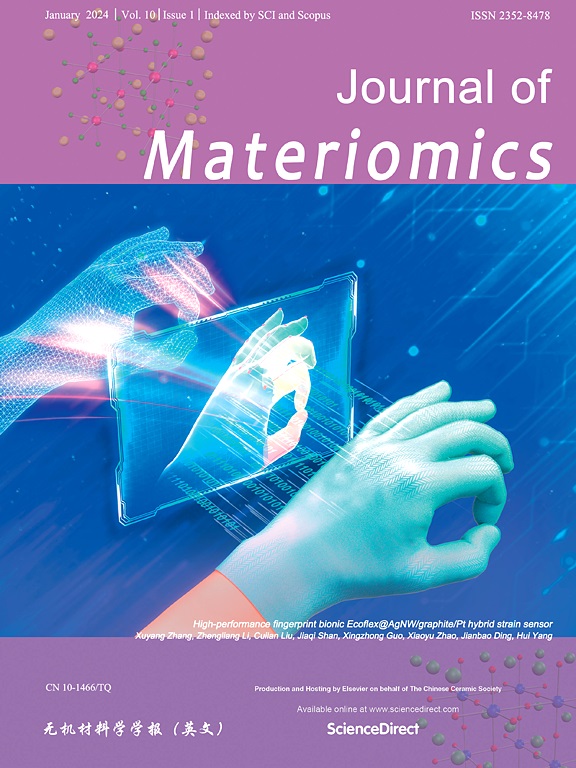Highly enhanced thermoelectric performance in (In, Pb) co-doped Bi-Sb-Te alloys via synergistic modulation of carrier concentration and band structure
IF 9.6
1区 材料科学
Q1 CHEMISTRY, PHYSICAL
引用次数: 0
Abstract
The extensive utilization of thermoelectric (TE) conversion technology necessitates stricter performance requirements for bismuth telluride (Bi2Te3)-based commercial materials. Despite the numerous optimization methods available for Bi2Te3-based materials, each optimization method has a certain upper limitation, and combining multiple strategies can achieve the optimal thermoelectric figure of merit (zT). In this study, the thermoelectric properties of (Bi,Sb)2Te3 materials are enhanced through the combined use of the heavy element Pb to regulate carrier concentration and the In element to optimize the band structure. Notably, indium (In) can suppress p-type antisite defects, which generate abundant Te vacancies, and help regulate the carrier concentration to its optimal level. This co-doping strategy achieves optimal carrier concentration, thereby enhancing the power factor (PF=4.57×103 μW⸱m–1⸱K–2), and generating abundant dislocations, the presence of the rich nano-second phase Sb2O3 contributes to reduced lattice thermal conductivity. Consequently, a peak zT value of 1.41 at 323 K and a high average zT value of 1.23 between 300 K and 500 K are achieved. Additionally, two pairs of thermoelectric modules, composed of p-type (Bi0.42Sb1.58)0.994(In, Pb)0.006Te3 and zone-melted n-type Bi2Te2.7Se0.3, demonstrate a conversion efficiency of 7.3% at a temperature difference of 250 K. This underscores the promising potential of these thermoelectric modules in commercialization. Thus, this study demonstrates the feasibility of combining multiple strategies and is expected to provide a potential reference for other thermoelectric systems.

通过协同调制载流子浓度和能带结构,(in, Pb)共掺Bi-Sb-Te合金的热电性能得到了显著提高
热电(TE)转换技术的广泛应用,对基于碲化铋(Bi2Te3)的商用材料提出了更严格的性能要求。尽管bi2te3基材料的优化方法众多,但每种优化方法都有一定的上限,多种策略的结合才能获得最优热电性能图(zT)。在本研究中,通过重元素Pb调控载流子浓度和In元素优化能带结构的组合使用,增强了(Bi,Sb)2Te3材料的热电性能。值得注意的是,铟(In)可以抑制产生大量Te空位的p型反位缺陷,并有助于将载流子浓度调节到最佳水平。这种共掺杂策略获得了最佳载流子浓度,从而提高了功率因数(PF=4.57×103 μW⸱m-1⸱K-2),并产生了丰富的位错,丰富的纳米第二相Sb2O3的存在有助于降低晶格导热系数。因此,在323 K时zT峰值为1.41,在300 K和500 K之间达到了高平均zT值1.23。另外,由p型(Bi0.42Sb1.58)0.994(In, Pb)0.006Te3和区熔型Bi2Te2.7Se0.3组成的两对热电模块在250 K温差下的转换效率为7.3%。这强调了这些热电模块在商业化方面的巨大潜力。因此,本研究证明了多种策略相结合的可行性,并有望为其他热电系统提供潜在的参考。
本文章由计算机程序翻译,如有差异,请以英文原文为准。
求助全文
约1分钟内获得全文
求助全文
来源期刊

Journal of Materiomics
Materials Science-Metals and Alloys
CiteScore
14.30
自引率
6.40%
发文量
331
审稿时长
37 days
期刊介绍:
The Journal of Materiomics is a peer-reviewed open-access journal that aims to serve as a forum for the continuous dissemination of research within the field of materials science. It particularly emphasizes systematic studies on the relationships between composition, processing, structure, property, and performance of advanced materials. The journal is supported by the Chinese Ceramic Society and is indexed in SCIE and Scopus. It is commonly referred to as J Materiomics.
 求助内容:
求助内容: 应助结果提醒方式:
应助结果提醒方式:


